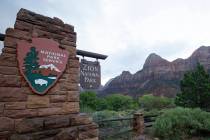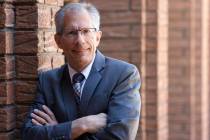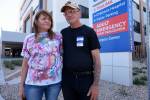Company sees future in space
They're building it in hope that space travelers will come.
Work is under way at Bigelow Aerospace's North Las Vegas production facility on Sundancer, the company's first human habitable spacecraft, company officials said Tuesday.
The inflatable module, now in "bits and pieces," will be big enough to hold three people, complete with life-support systems and a docking port, where private astronauts and paying space travelers will arrive on transportation spacecraft while Sundancer orbits some 200 miles above Earth, they said.
"We're basically creating the destination. Transportation is going to be up to the rest of the industry," Bigelow Aerospace spokesman Chris Reed said.
No date has been set for a launch, but program managers said their target is mid-2010.
The company's president and founder, Robert T. Bigelow, made a special announcement late Monday, saying he is accelerating the Sundancer project because of rising costs in Russia, where both his Genesis I and Genesis II inflatable modules were launched on July 12, 2006, and June 28, respectively.
As a result, he said, the company will forgo launching next-generation Galaxy modules, citing the success of its Genesis crafts.
"Price hikes have been most acute in Russia due to a number of factors including inflation, previously artificially low launch costs and the failing value of the U.S. dollar," Bigelow said in a statement.
"The dramatic rise in launch costs has forced us to rethink our strategy with Galaxy," he said. The company still plans to build Galaxy, but its systems will be validated on land without putting it in orbit.
"We have decided to expedite our schedule yet again, and are now planning to move ahead directly with Bigelow Aerospace's first human habitable spacecraft, the Sundancer," Bigelow's announcement reads.
"By eliminating the launch of Galaxy, we believe that BA (Bigelow Aerospace) can move more expeditiously to our next step by focusing exclusively on the challenging and exciting task presented by the Sundancer program," he said.
So far, Bigelow's space modules have carried personal mementoes and insects that survived the launches of the twin 14-foot-long, Kevlar-layered Genesis spacecraft.
Genesis II was launched with a "Biobox" experiment containing live red harvester ants from Nevada, giant hissing cockroaches from Madagascar and South African flat rock scorpions.
But Bigelow said a human spaceflight program "is the reason that I and others began this effort in the first place."
The Genesis modules are expected to orbit for 13 years each before surrendering to Earth's gravitational pull and burning up while re-entering the atmosphere.
Program managers said Sundancer, on the other hand, is being designed to stay in orbit for 10, 20 or 30 years by using a propulsion system that can maneuver the module, which will be more than 28 feet long and 20 feet in diameter and have 15 times more interior capacity than the Genesis modules.
"We have to do significant facilities enhancement and tooling enhancement just to handle the scale," said Eric Haakonstad, deputy program manager for the Sundancer project.
He said Sundancer will have more electronics and expanded communications capabilities. Once built and launched, it will orbit several months for an unmanned component evaluation.
Jay Ingham, program manager for docking and propulsion operations, said the first visitors to Sundancer will be Bigelow Aerospace astronauts who "will unpack it and make it more comfortable to live on board."
Among the most challenging aspects of the Sundancer program is developing life-support systems, Ingham said.
More than 90 percent of the oxygen on board will be recycled, he said. Engineers are exploring different ways of generating oxygen by extracting it from carbon dioxide or using an electrical process to release oxygen atoms from water.
Another hurdle to clear is building a more sophisticated avionics to handle communications and navigation.
"We're building a lot of prototypes," Ingham said.
He noted that Sundancer's external makeup will be similar to the Genesis modules, but the "orbital debris shield will be made of higher strength stuff than Genesis."
Because of the size of Sundancer, launching will require a substantially larger missile.
"Several options are open," he said. "There are a couple existing (U.S.) rockets and Russian rockets as well."
Haakonstad said Sundancer is being designed to link up with other modules to form a complex of orbiting habitats.
Bigelow, owner of the Budget Suites of America hotel chain, has committed $500 million toward building a commercial space station by 2015.























